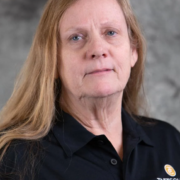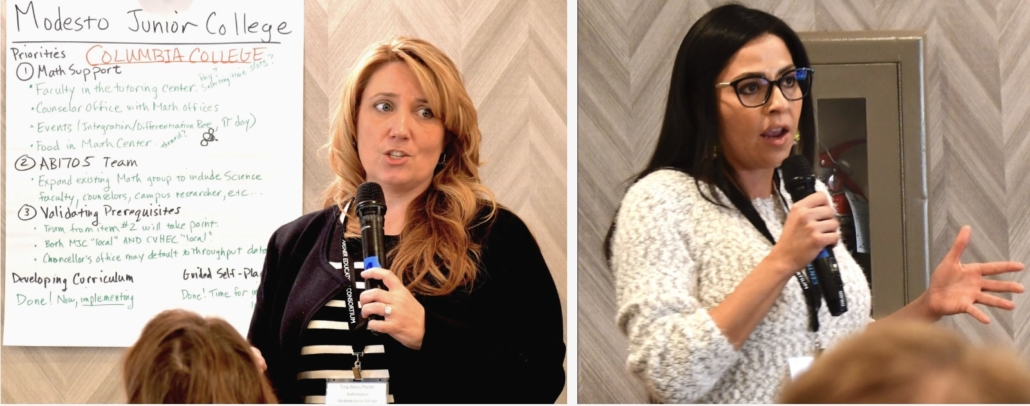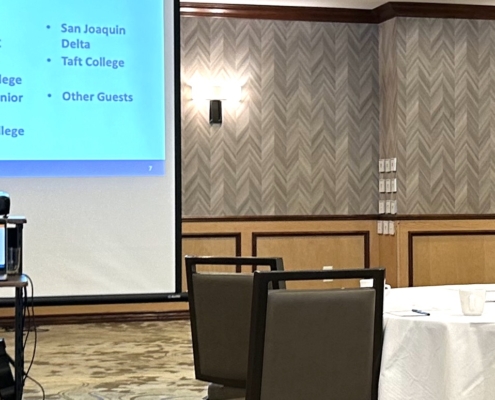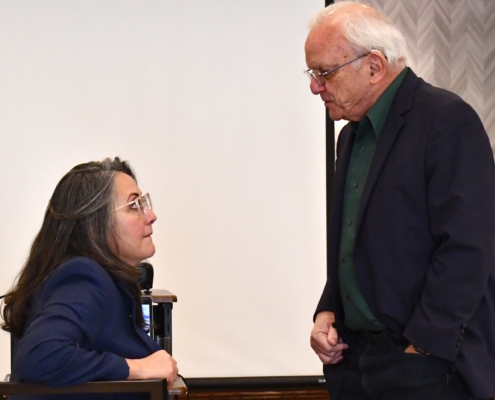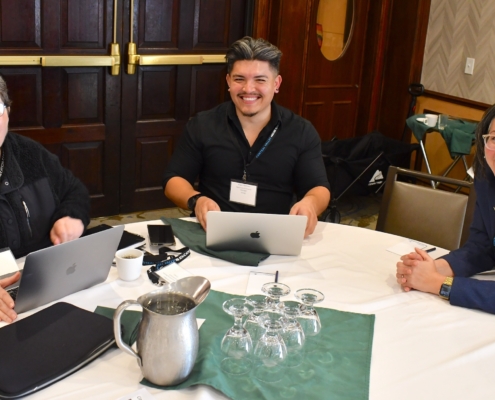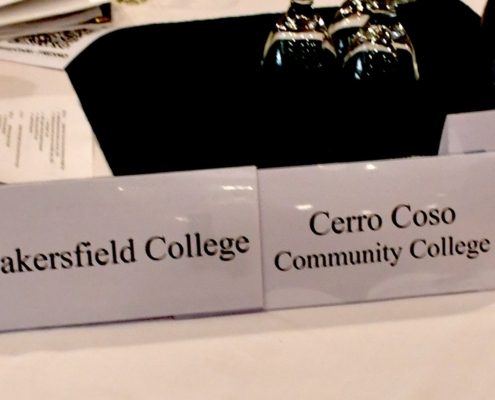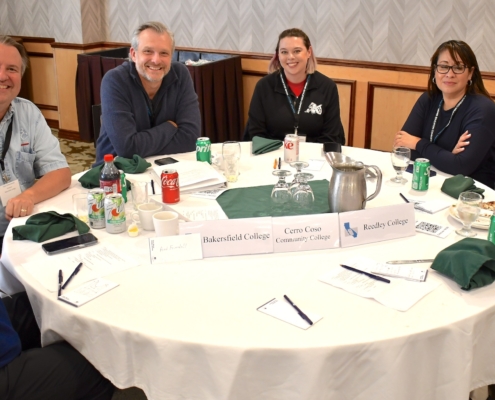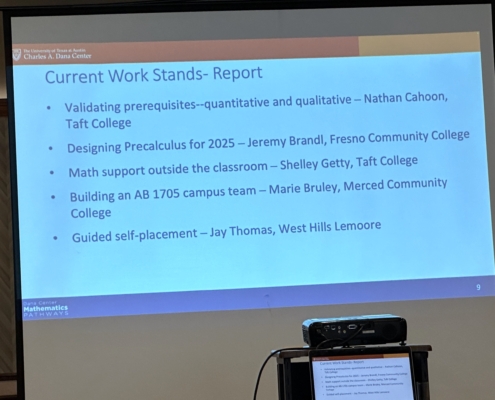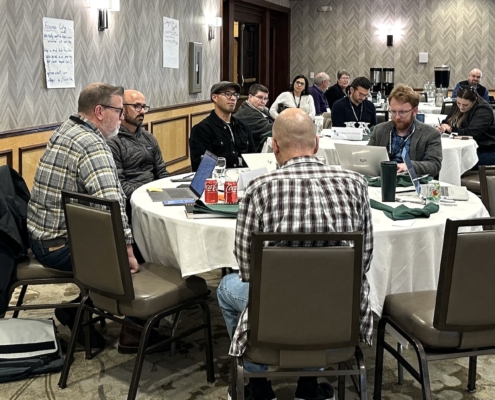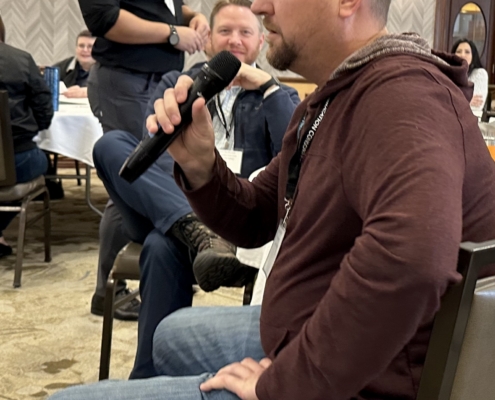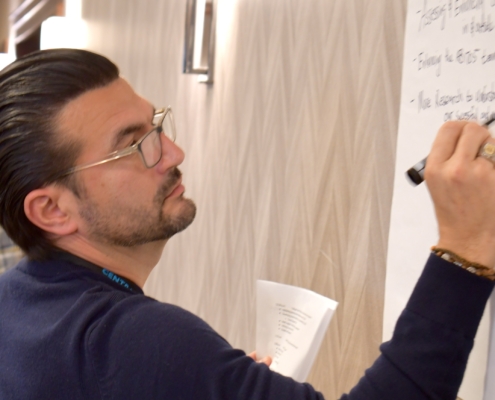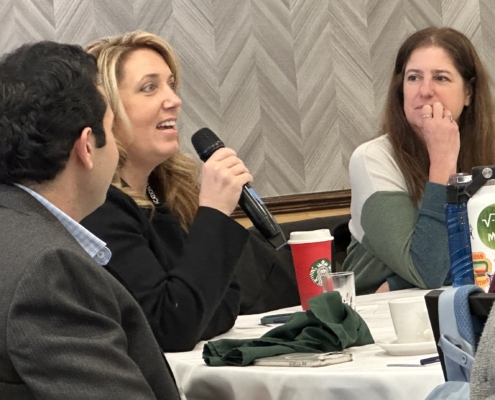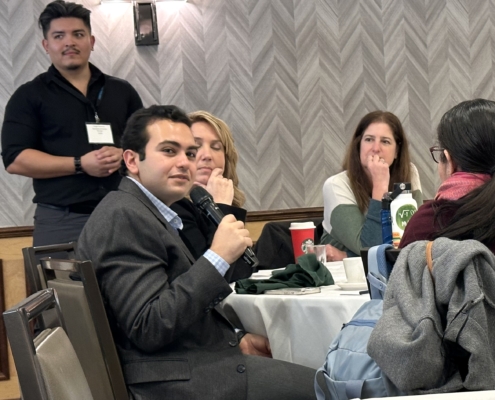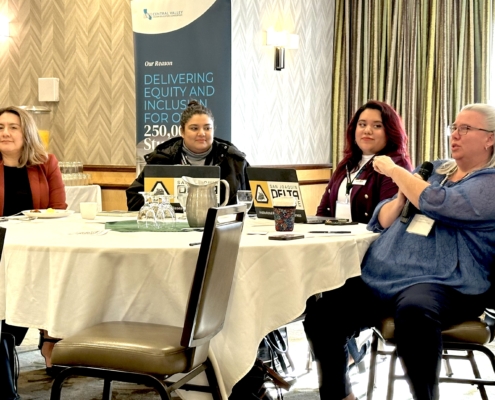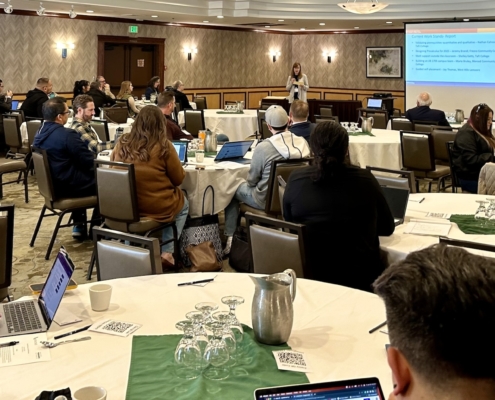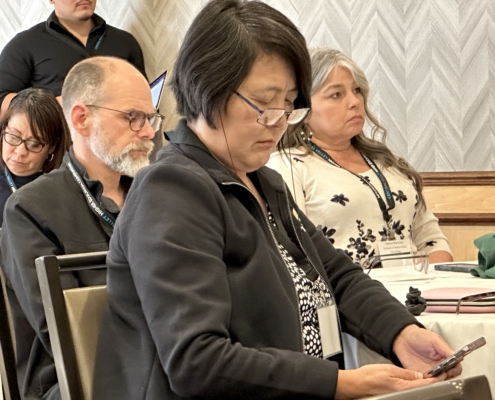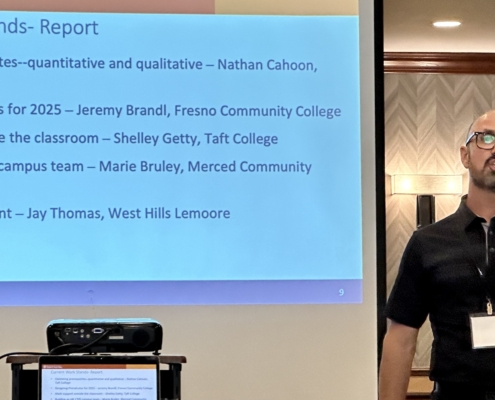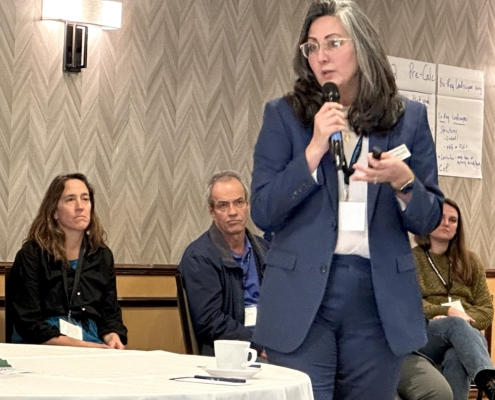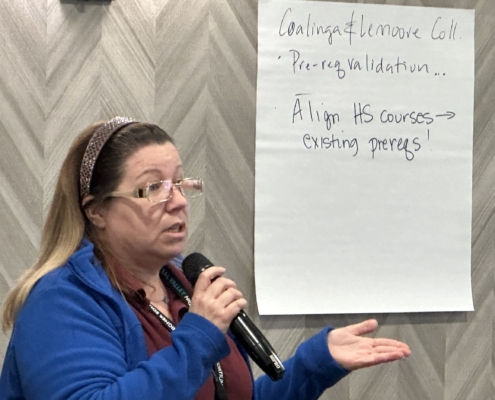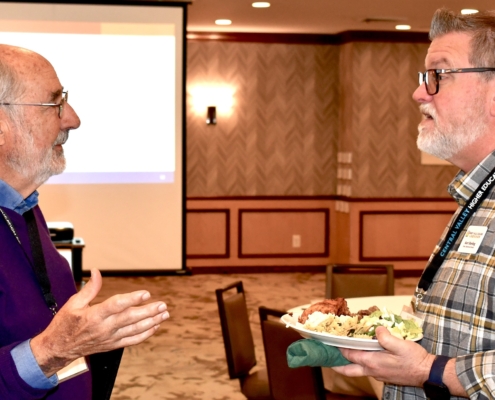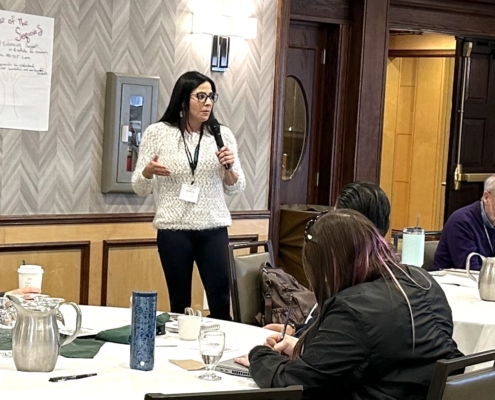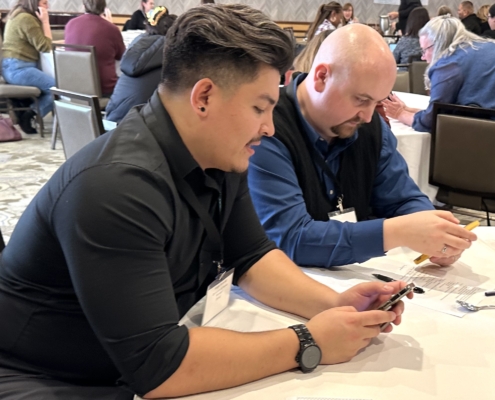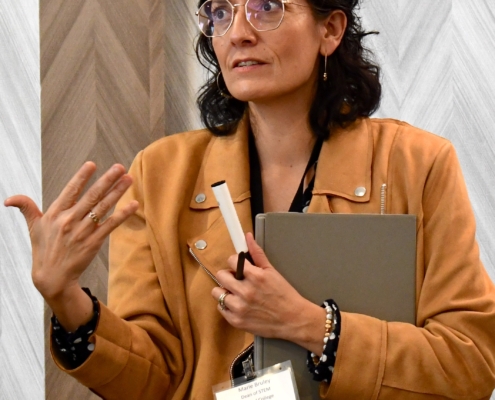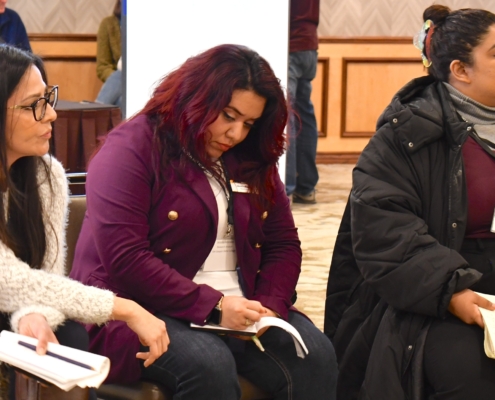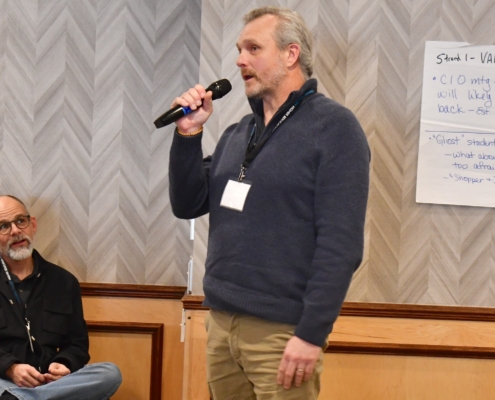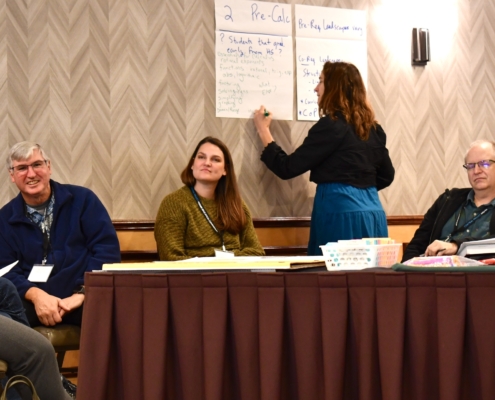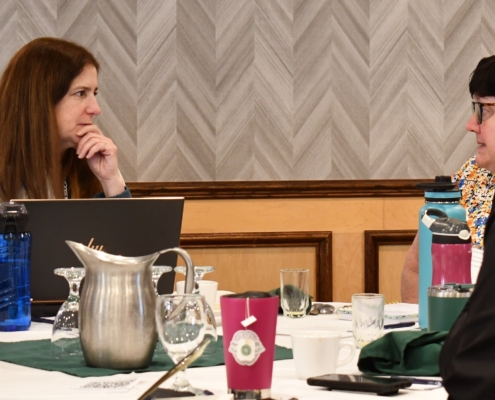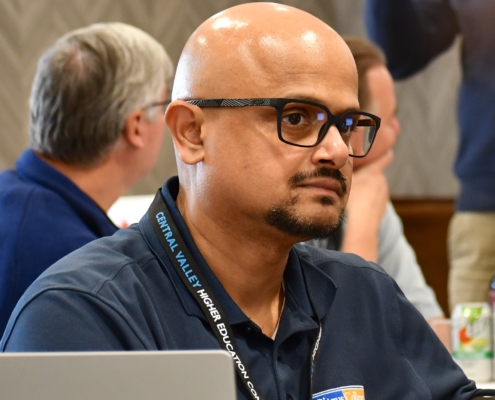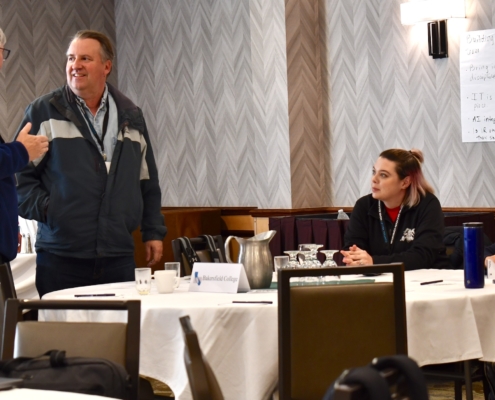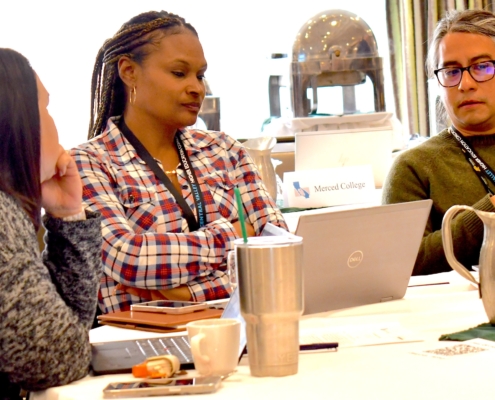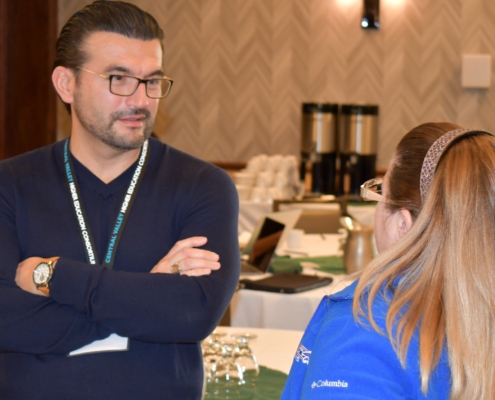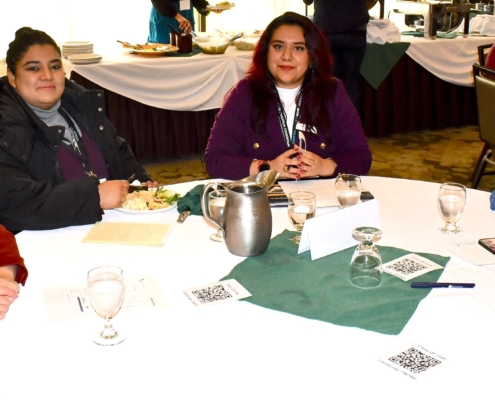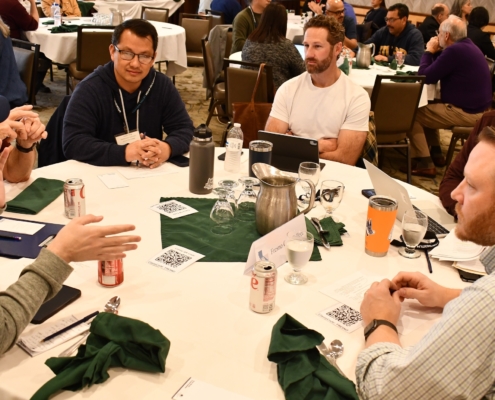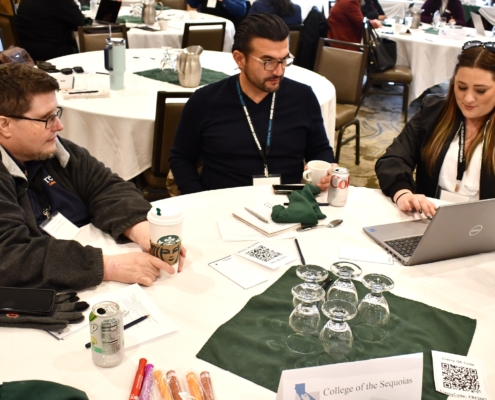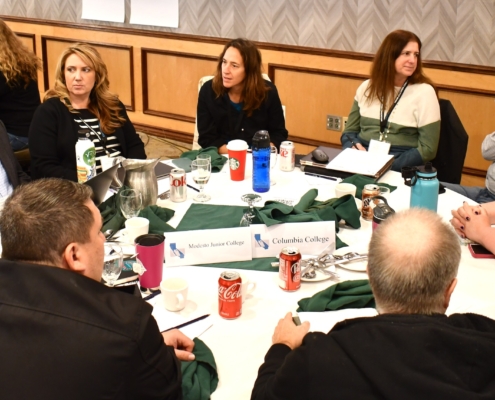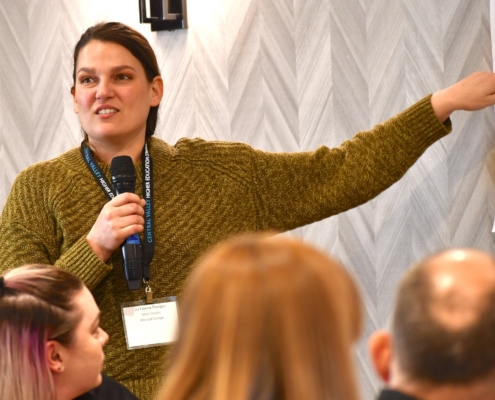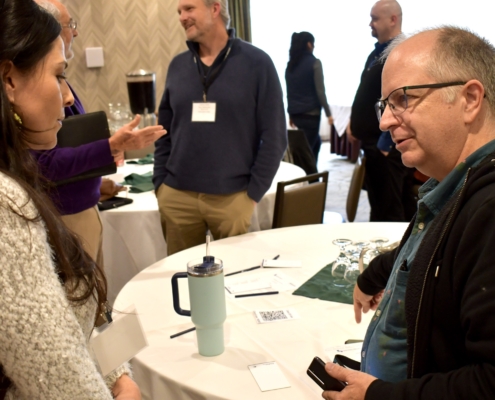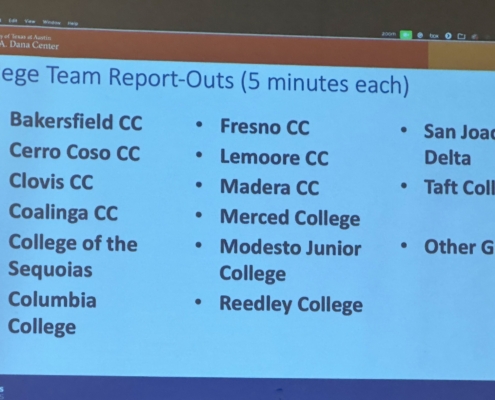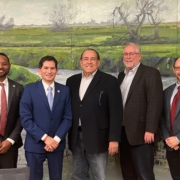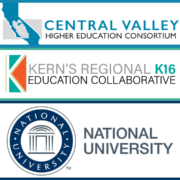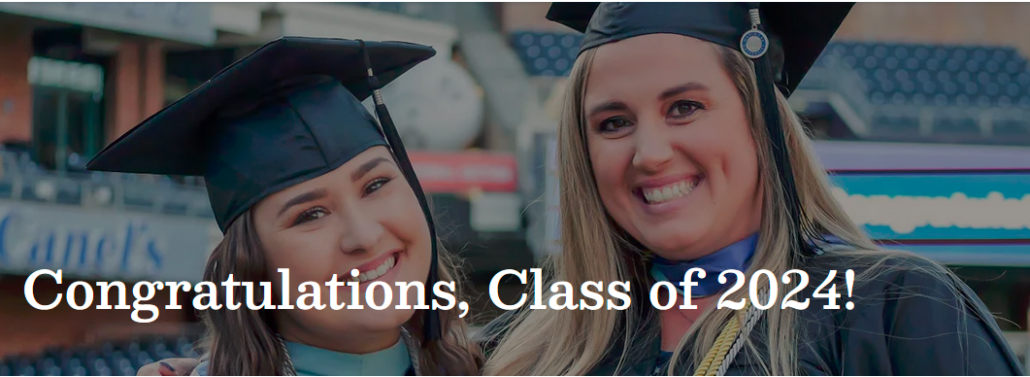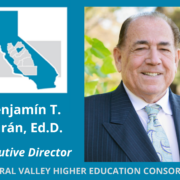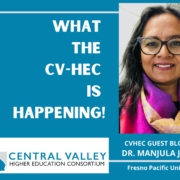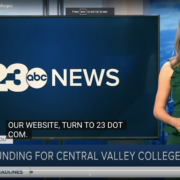MATH TASK FORCE: ‘Something extraordinary’ (Jan. 26 wrap)
Modesto Junior College math professor Tina Akers-Porter discusses her strand group’s deliberations at “The Central Valley Way to AB1705 Success” Convening Jan. 26 where a call for a “principals task force” by Orosi High School Principal Marlena Celaya would bring more secondary education voices to the table.
‘Something extraordinary is happening in math in California’s Central Valley’
Math Task Force latest AB1705 session leads to calls
for more data, high school input, re-convene April 19
BY TOM URIBES
CVHEC Media/Communications Coordinator
Realizing that state guidance surrounding Assembly Bill 1705 remains elusive, valley community college math educators and officials forged ahead at “The Central Valley Way to AB1705 Success” convening Jan. 26 in Fresno with a determined and unified mindset to develop implementation plans that will serve the best interests of their students including a follow-up session set for April.
In addition, the Central Valley Higher Education Consortium (CVHEC) Math Task Force discussion centered around five strands of curriculum planning for implementation before the law goes into effect July 1, two aspects emerged at the lively day-long work session: the increased participation of institutional researchers for pertinent data-collecting and a call for a “principal’s task force” to bring upper secondary education voices to the table.
Presented by CVHEC, the convening — the latest in a series of deliberations since fall — was attended by 82 representatives from the consortium’s 19-member community colleges, one high school principal and campus research professionals.
They agreed to reconvene April 19 for reports on follow-up work that will occur as a result of this most recent event. Registration for that event will open next month with additional details forthcoming.
Facilitated by the Charles A. Dana Center at the University of Texas at Austin, the session last month reviewed five strands of curriculum planning: Validating Prerequisites; Designing Precalculus for 2025; Math Support Outside and Inside the Classroom; Building an AB 1705 Campus Team; and Guided Self-Placement.
“With tensions high and little guidance surrounding AB1705, the 19 community colleges and districts that comprise the CVHEC nine-county region are rolling up their sleeves and getting to work on this math movement the ‘Central Valley Way’,” summarized Tammi Perez-Rice of the Dana Center.
Perez-Rice, who co-facilitated the event, said the convening was solely dedicated to working and planning at a regional and institutional level in two parts. The first part was dedicated to expanding the five work groups that emerged from the Nov. 17 webinar and creating a plan to move forward. The second half of the convening was devoted to institutional planning.
“The fruits produced from these convenings are already being felt around the region,” Perez-Rice said. “The plans and implementations emerging from these convenings are more than just a response to AB705 and AB1705; they cultivate systemic reforms that will benefit all students in the CVHEC region and beyond.”
John Spevak, CVHEC regional coordinator who oversees the consortium’s Math Task Force and co-facilitator of the Jan. 26 gathering, said in the short-term, the five strands work groups will continue to communicate and provide updates in preparation for the April 19 convening. The strand leads are preparing summaries of their Jan. 26 breakout discussions and member college teams are preparing summaries of the tentative plans they developed in the afternoon breakout sessions for oral reports in April.
“In the longer term, our Math Task Force will continue to monitor what the California Community College Chancellor’s Office says, while mainly going forward with our own Central Valley approach to the five strands.”
That “Central Valley Way” stems from the work undertaken by the CVHEC Math task Force, first formed in 2019, in the past year that was intensified with four work sessions beginning Oct. 6 in a virtual convening with CCC vice-chancellor Eric Cooper. The first in-person session followed Oct. 13 in Fresno and another virtual session was held in two parts Nov. 17 before the Jan. 26 session.
These sessions may represent the only concerted effort by a region’s community college math community actively meeting to collaborate across campus boundaries for ways to unite as one voice and determine a curriculum course of action that meets the law’s intent, Spevak said.
“We at CVHEC, along with the Dana Center representatives and our College Bridge partners in the Math Bridge Program, feel that something extraordinary is happening in math in the Central Valley of California,” Spevak said.
After the Jan. 26 session ended, Perez-Rice reiterated a point she made the first time she visited Fresno for the first in-person convening last fall:
“This collaboration today was amazing. As I travel and talk to math faculty all over the country, what I see pulsating from the CVHEC community here in Central California is just compassion; caring about their students; putting their students first; understanding what their students need; and more importantly collaborating with each other working across institutions to make things happen.”
Inviting secondary ed voices to ‘align syllabi’
A key development of the convening was the assertion and agreement that a crucial next step is “to involve high schools in the discussion and determine how to breakdown barriers between systems for a cohesive collaborative effort to put students first across the state of California,” a message delivered by Marlena Celaya, principal of Orosi High School who was the only secondary education official in attendance.
Celaya’s comments, first in a strand session and later in general comments before the assembled group, resonated with the community college professionals as she offered to lead a task force of principals/administrators who would unify with the CVHEC community college math educators for implementation strategy — to listen and hear what the needs are and how to meet those needs.
“I’m willing to lead this work because I don’t want people to go through the wars I went through teaching algebra and volunteering all my time,” said Celaya, a former math teacher at Dinuba High School. “We would want to hear from community colleges and say to them ‘what do you need?’
“We heard something from you today: ‘I want to know what courses are offered at the high school and what does that course description look like?’ Aligning syllabi is what I’d like to do,” Celaya said. “Mathematics is my passion.”
Perez-Rice said the April 19 convening promises more high school representation, with over twelve principals who are part of the Math Bridge Program by CVHEC and College Bridge being invited. Other secondary education officials from throughout the valley are welcome she said.
Participant feedback: ‘great to see we’re not alone in this …’
After the event, several participants shared their assessment of the Jan. 26 convening.
“The conversations were amazing and we really appreciated being here,” said Joshua Lewis, chair of the Bakersfield College Mathematics Dept.
“There have been so many legislative changes and so many unknowns it’s nice to see the work that other campuses are doing and realize that we’re not alone, that we have shared values; that we have shared emphasis on student learning and really care about doing right by all of our students,” he added.
Nathan Cahoon, Taft college math professor, felt that the efforts of CVHEC’s Math Task Force as exhibited at the convening is strengthening the voice of the valley’s math community which will have an impact.
“It was amazing to work with incredible professionals who have some really amazing ideas,” he said. “I know I took many good notes about ideas to implement at our college. The connections we are building here with each other will be powerful down the road as we build a cohesive effort to get some good research together that we can send to the state as one voice from all the colleges.”
Modesto Junior College math professor Marina Hernandez said coming together within the region is relished because when attending other statewide or national conferences, the focus is not as localized.
“It was very helpful to learn what other colleges in the Central Valley are doing because we share similar student population and resources characteristics and their best practices are applicable to us here in our region,” Hernandez said.
Tina Akers-Porter, Modesto Junior College math professor, said the Math Task Force work has helped her better understand what AB1705 is and what it means for her students.
“I feel like I have a better understanding of some of the challenges of the legislation and what others are worried about,” she said. “We share some of those worries but it’s great to hear different points of view on that. A byproduct of this is we are seeing how we need to support underprepared students more, inside and outside the classroom, and sharing ideas to do that.”
Shelly Getty, Taft college math faculty and a strand leader, echoed Akers-Porter: “We left knowing we are going to start some specific tutoring and targeting students for tutoring. We will try to advertise it better and recruit so students get more access to the services we already provide which will greatly impact them. We shared some good ideas on how to do that effectively.”
Marissa Martinez, Taft college math professor, said, “We have our work cut out for us. There’s a lot of things that we have to address with a lot of moving parts. Everything keeps changing but it was great to be able to see that we’re not alone in this, that we’re working together to better serve our students.”
She said this intercollegial collaboration and the feedback from the colleges helps “so we don’t have to reinvent the wheel — what worked, what didn’t work.”
Next steps? Data research
“I would say the next step is collecting our data to see how the numbers show where we are so we can prove that these courses are important for our student success,” Martinez said.
This data aspect was also a key part of the convening as institutional research professionals were invited and directly participated such as Arooj Rizvi, research analyst in the Office of Institutional research and Effectiveness at San Joaquin Delta College.
“Researchers have a monumental role in the implementation of AB 1705 because policymakers are going to depend a lot on what we are able to produce as a group or even as an institution,” Rizvi said. “Being a part of these conversations helps us to see the bigger picture, the context and the requirements of what exactly it is that we are looking for in the data.”
She said it was exciting to hear at the convening what area colleges are going through.
“I realized how similar our challenges are from institution to institution, “she said. “Working through that together and being solution-oriented is something that’s going to take all of us towards a beneficial direction. Seeing us all here today was a defining moment in history.”
Owynn Lancaster, vice president of academic strategy for CVHEC partner College Bridge, said the event was “a huge success seeing folks come together from math to talk about math and really pool their resources to address actual challenges.
“The most powerful focus of change in education is always the educator,” Lancaster said. “I know everything’s heaped on them but in a lot of ways they have the greatest power of the greatest agency for this.”
For more info: centralvalleyhec@gmail.com
For CVHEC media inquiries: Tom Uribes – cvheccommunications@mail.fresnostate.edu (or text 559.348.3278).
See also:
https://bit.ly/MTFconveneKSEE24
Valley’s math ed experts unite to address AB 1705 challenge for student success
The CVHEC Way to Math Success — Implementing AB1705
Math Task Force begins discussion of AB1705 implementation – Nov. 17 next
CVHEC Math Task Force meets in-person Oct. 13 for AB 1705 follow-up
NEWS RELEASE – CVHEC Math Task Force: Impactful legislation (AB 1705) Convenings Oct. 6 & 13
CVHEC Website Feature: Math Task Force Page
PHOTO GALLERY
Central Valley Transfer Project: valley’s four-year colleges collaborating
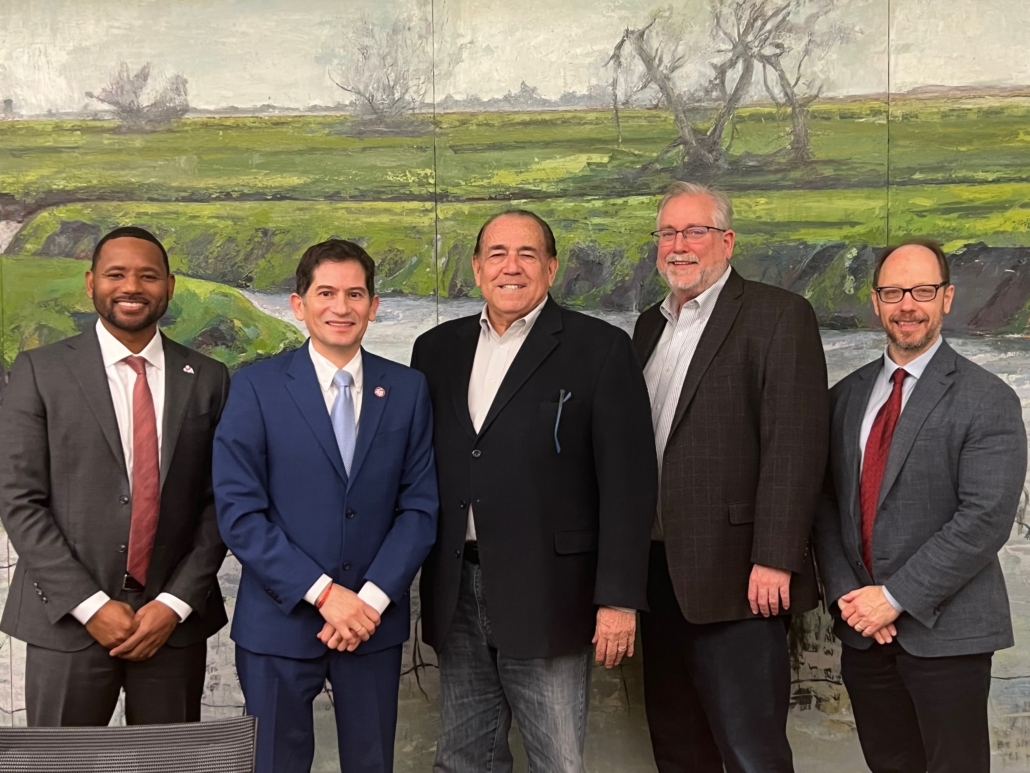
Fresno State, a founding CVHEC member, joined CVHEC’s historic Central Valley Transfer Project in January with (from left): Dr. Kent Willis, vice president of Fresno State Student Affairs and Enrollment Management; University President Saúl Jiménez-Sandoval; Dr. Benjamin Duran, CVHEC executive director; Tom Burke, CVHEC regional coordinator; and Dr. Sergio La Porta, associate dean of the Fresno State College of Arts and Humanities.
Fresno State joins in transfer ‘centerpiece’ with
11 CVHEC community colleges, 3 CSUs, UCMerced
The Central Valley Transfer Project is now partnered with the region’s three California State University campuses after Fresno State signed on in January joining Bakersfield and Stanislaus in the historic Central Valley Higher Education Consortium initiative designed to open new doors for students’ successful transfer from community college.
Along with founding partner University of California, Merced, this means the valley’s four public institutions of higher education are working in unison with 8 community colleges currently through CVHEC’s project using the groundbreaking Program Pathways Mapper software. The project has also gained the full support of the California Community College Chancellor’s Office.
The community colleges already in the CVTP, with several more expected to sign on this year, are: Bakersfield College, Clovis Community College, Madera Community College, Merced College, Porterville College, Reedley College, West Hills College-Coalinga and West Hills College-Lemoore.
The Transfer Project is also expanding participation in the north end of the Central Valley with Modesto Junior College, Columbia College and San Joaquin Delta College scheduled to begin onboard this spring for a total of 11 community college partners said Stan Carrizosa, CVHEC regional coordinator and consortium lead for the project.
All Transfer Project partners are members of the consortium with their respective chancellors and presidents serving on the CVHEC Board of Directors.
“The Transfer Project is now a centerpiece for students to both enter and transfer from community college to their four-year universities,” said Dr. Benjamín Durán, CVHEC executive director. “We are excited to share this latest progress of the project which has been featured statewide and nationally at conferences such as the Community College League of California and Complete College America.”
He added, “This innovative approach is the only one in the state that includes a University of California campus collaborating with partner California State University and community colleges in establishing transfer pathways for Central Valley students to get them to and through college in a timely manner.”
Dr. Saúl Jiménez-Sandoval, Fresno State president and CVHEC board member, said, “I’m proud that Fresno State will be a dynamic partner in the Central Valley Transfer Project, as this pathway will empower community college students to become visionary Bulldogs.”
The Fresno State agreement was finalized Jan. 17 between Durán and President Jiménez-Sandoval, with Tom Burke, CVHEC regional coordinator and Transfer Project team member; Dr. Kent Willis, vice president of Enrollment Services; and Dr. Sergio LaPorta, associate dean of the College of Arts and Humanities.
At CVHEC’s Higher Education Summit last fall, CCC Chancellor Sonya Christian announced that the statewide system has designated the Transfer Project as a demonstration project as set forth in her Vision 2030 for all California community colleges. The Transfer Project’s participating community colleges are serving as the pilot campuses with plans to implement statewide.
Carrizosa said the state budget continues to support and fund the onboarding costs for all community colleges to subscribe to the Program Pathways Mapper.
Established in 2021 with UC Merced, Merced College and Bakersfield College, the project is designed to open new doors for students to successfully transfer from community college with its Program Pathways Mapper, Carrizosa said.
He said the Program Pathways Mapper — a public facing, internet-based app that can be downloaded and accessed by the public software platform — provides unprecedented ease of access for students, counselors, advisors and parents much more so than other existing platforms.
“There are no typical requirements for access to PPM such as other internal college systems like Degree Works, Assist.Org and the CSU Transfer Planner,” he said. “These are all course tracking systems but in order to use them, students need to be successfully enrolled in college and have a student email address or other form of login to try and plan. Through PPM students simply upload the public PPM app to their devices and have immediate access.”
Carrizosa said the PPM helps simplify the transfer planning process which can be the most difficult task for many students.
“In much of our Central Valley region, as many as seven out of 10 incoming college freshmen will be first generation students to attend college,” he said. “Research shows that the most difficult task for them is often the application process itself and completing the required steps for enrollment. Systems like Degree Works and others do nothing to remove this common barrier because these systems cannot be accessed until a student successfully enrolls.”
He explained that a high school student can start the Transfer Project journey as a junior or senior by enrolling in college dual enrollment courses enabling them to complete their transfer level English and Math courses while still in high school. These units roll up with them as they enter community college and track the completion of their lower division requirements for their Associate Degree for Transfer in their chosen major via PPM.
“Students can easily select a community college they wish to attend and a major they want to pursue and the lower division courses required are sequentially laid out for them through the Program Pathways Mapper software.”
In addition, the PPM then links those lower division courses to an upper division institution of the student’s choice and shows a clear sequence of upper division courses needed to complete the degree, Carrizosa added.
“The PPM contains clear and accurate information directly from course catalogues from all participating colleges,” Carrizosa said. “The Central Valley Transfer Project is becoming an alternative continuum of courses to the traditional high school A-G or Career Technical Education continuums and is unprecedented in the state’s community college system. We call it ‘The Central Valley Way!’”
“Through the use of PPM, students complete exactly what is required of them to successfully transfer to their four-year university and they follow PPM through their last two years to degree/certificate completion,” Carrizosa said.
Baseline data results also demonstrate the promise that PPM delivers in the Transfer Project.
In a sample of 5,000 incoming freshmen to Bakersfield College in 2022 the students using the PPM increased their “percentage of on-path course completion” to over 80 percent which also closed the equity gap in this statistic for ethnic minority students when compared to their white counterparts, Carrizosa said.
“The same sample showed students using the PPM reduced the ‘number of units-to-degree’ from an average of 87 down to 67,” he added.
The project is now gearing up to expand the partnership with the College Bridge Math Project and to onboard community colleges from the northern region of the Central Valley.
For more information about the CVTP, contact Carrizosa at centralvalleyhec@gmail.com.
CVHEC media inquiries: Tom Uribes – cvheccommunications@mail.fresnostate.edu or text 559.348.3278.
Fresno State media inquiries: PIO Lisa Bell – lbell@csufresno.edu.
See:
· Pilot CVHEC/UC Merced Transfer Project improves process for students
· CVHEC Web Site Feature: Transfer Project
· Historic Transfer Project spurs statewide movement to increase transfer rates
· HIGHER ED NEWS: College Bridge to expand Math Bridge; CVHEC Transfer Project
• A-G
Kern Master’s Upskilling Program: 2nd cohort graduates – next cohort recruitment underway
Two cohorts from the Kern Master’s Upskilling Program (MA English) are eligible to participate and walk in the 2024 National University Commencement May 18 at Petco Park in San Diego. The program’s high school teacher participants are now qualified to teach English dual enrollment community college courses on their respective campuses. A third English cohort and the first Kern math cohort graduate in June.
Kern Master’s Upskilling Program
reaches another milestone
Second English cohort graduation – recruitment underway for a fall math cohort
The Kern Master’s Upskilling Program for high school teachers seeking a master’s degree in English or Math that qualifies them to teach dual enrollment courses at their respective campuses reached its second milestone last month when 11 participants completed post-baccalaureate requirements in English through National University.
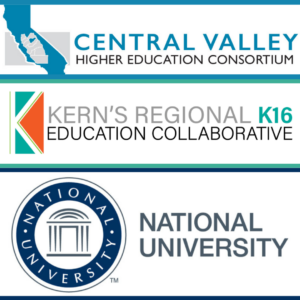 Formally known as the Dual Enrollment Teacher Upskilling Pathway for English and Mathematics, the Central Valley Higher Education Consortium initiative is in partnership with the Kern Regional K-16 Education Collaborative that was funded as part of an $18 million statewide competitive grant in June 2022 to improve student progress from high school to postsecondary education and ultimately into the workforce.
Formally known as the Dual Enrollment Teacher Upskilling Pathway for English and Mathematics, the Central Valley Higher Education Consortium initiative is in partnership with the Kern Regional K-16 Education Collaborative that was funded as part of an $18 million statewide competitive grant in June 2022 to improve student progress from high school to postsecondary education and ultimately into the workforce.
The program also announced recruitment is underway for a third math cohort of 21 students to begin this fall for completion in spring 2026 though Fresno Pacific University in concert with the Kern County Superintendent of Schools (KCSOS), which serves as the administrative agent for the Kern K-16 Collaborative.
Informational meetings are set for March 21 and April 11 at 4:30 p.m.
A potential fourth English cohort pilot through CSU, Bakersfield with seven students is also in the works said Tom Burke, CVHEC’s Kern Masters Upskilling Program lead who reports that the program progress “has been very good” since it was funded two years ago.
“With the first two cohorts of English graduates to be joined by our first cohort of math graduates this summer, we are well on the way to significantly increasing the number of faculty in Kern County eligible to teach dual enrollment or community college courses in math and English,” Burke said.
The January graduation follows the first cohort of 11 English students who graduated in September for the innovative state-funded CVHEC initiative that helps reduce the cost of tuition for high school teachers to pursue a master’s degree, a state requirement to teach community college dual enrollment courses.
Each NU cohort group of students is eligible to participate and walk in the 2024 Commencement services set for Saturday, May 18, at Petco Park in San Diego, said Jessica Gladney, senior director for Partnership Development/ Workforce Education Solutions for National University,
The first Kern Master’s Upskilling Program cohort — MA, English with a specialization in Rhetoric — began in January 2023 with 13 out of 15 students completing their program in November 2023 (nine of the 13 will graduate with honors with a grade point average of 3.85 and above).
The two remaining students are currently in the process of completing their capstone, which is the culminating course of the master’s program, Gladney said.
The second Kern Master’s Upskilling Program cohort of MA, English with a specialization in Rhetoric, began in March 2023, and 10 out of 15 students completed their program in January 2024. The remaining students are currently in the process of completing their capstone course, Gladney reports.
She said each NU cohort group of students is eligible to participate and walk in the 2024 Commencement services set for Saturday, May 18, at Petco Park in San Diego.
“We are proud of these candidates and we are excited to assist with building a qualified candidate pool of eligible dual-enrollment English teachers to meet the workforce demands in the Central Valley,” Gladney said.
CVHEC, made up of 28 institutions of higher education in the valley’s nine-county region from San Joaquin to Kern counties, is one of several partners in the Kern Collaborative.
South Valley CVHEC members include California State University, Bakersfield; Kern Community College District; Bakersfield College; Cerro Coso College; Taft College; Porterville College; Fresno Pacific University; and National University.
The project also includes the CVHEC Mentor Program that pairs the master’s candidates with a community college mentor to support them along the way and help them navigate the process to becoming an adjunct community college faculty member.
Under coordinators Dr. Liz Rozell (math) and Dr. Vikash Lakhani (English), the program is still accepting community college professors to serve as mentors, Burke said.
For more details about the fall 2024 math cohort through Fresno Pacific, potential students can contact:
- Manjula Joseph, program director – manjula.joseph@fresno.edu or 559.453.2096
- Nathan Lyness, senior Outreach & Admissions representative – nathan.lyness@fresno.edu or 559.453.7183
See:
- CVHEC Teacher Upskilling Program for Master’s Degrees Supports Dual Enrollment in South Valley via Kern K-16 Collaborative Grant (June 23, 2022)
- Rozell, Lakhani Named CVHEC’s Kern Faculty Mentor Coordinators (February 22, 2023)
- CVHEC IN THE NEWS: KBAK features Kern Master’s Upskill Program (November 17, 2022)
- Tom Burke Named Kern Master’s Upskill Lead (November 16, 2022)
- Herrera to Head Kern Regional K-16 Education Collaborative (July 13, 2022)
- KCSOS Mary Barlow Announces $18.1M Workforce Grant (KCSOS press release – June 9, 2022)
- “Blurring the Lines Between High School and College: Dual Enrollment in the Central Valley”(CVHEC video – March 2022)
CVHEC DIRECTOR’S MESSAGE (September 2023)
An ambitious fall 2023 semester!
Greetings Colleagues and Friends of CVHEC,
Welcome to the fall 2024 semester and the September edition of the CVHEC e-Newsletter. We hope the summer provided you with an opportunity to enjoy some personal time to recharge, reconnect with family and perhaps finally get some long-planned travel in.
WITH THIS EDITION of our newsletter, we announce phase one of the CVHEC Open Educational Resources Improvement Project introduced previously: the awarding to member West Hills Community College District of a $580,180 mini-grant from the Fresno-Madera K-16 Collaborative.
 This funding will expand on West Hills College-Lemoore’s pioneer work with faculty and instructional administrators developing OER/ZTC textbooks, courses and pathways that serve area institutions and their feeder high schools in a collaboration of CVHEC members in the WHCCD and State Center Community College District (Fresno, Madera, Clovis, Reedley colleges) leading to a full ZTC degree pathway in Elementary Education shared with project stakeholders that immediately serves the Fresno-Madera areas. CVHEC’s OER/ZTC efforts will be scaled throughout across the Central Valley.
This funding will expand on West Hills College-Lemoore’s pioneer work with faculty and instructional administrators developing OER/ZTC textbooks, courses and pathways that serve area institutions and their feeder high schools in a collaboration of CVHEC members in the WHCCD and State Center Community College District (Fresno, Madera, Clovis, Reedley colleges) leading to a full ZTC degree pathway in Elementary Education shared with project stakeholders that immediately serves the Fresno-Madera areas. CVHEC’s OER/ZTC efforts will be scaled throughout across the Central Valley.
AS NOTED IN previous newsletters, we are delighted by the appointment of our own Dr. Sonya Christian, former chancellor of the Kern Community College District, as the new leader of the California Community Colleges Chancellor’s Office and the start of her tenure June 1. Now, we are further delighted to announce that Chancellor Christian will join us as the keynote speaker to open our annual CVHEC Summit scheduled for Friday, Oct. 20. See the save-the-date and registration information in this issue. We hope you are planning on joining us for the summit.
AND FINALLY, WE are pleased to present in this issue’s “What in the CVHEC is Happening” blog a special back-to-school message also by Dr. Spevak. He shares an email he received from a former student who attributes his success today to teachers like John, a former English teacher and vice-president emeritus of Merced College. It’s a timely message as so many educators return to the classroom for the fall semester and that ever-gratifying sense of making a difference in students’ lives. Cheers to teachers everywhere!
Enjoy our newsletter and may you all get off to a great start this fall.
CVHEC DIRECTOR’S MESSAGE (Summer 2023): Affirmative Action challenge!
Supreme Court ruling is not the death of Affirmative Action but
rather a challenge to renew and reinforce its spirit and outcomes
NOTE: See the June 24, 2023 Fresno Bee Op-Ed version of this message: https://bit.ly/CVHECoped-RenewAffirmativeActionSpirit.
Greetings Colleagues and Friends of CVHEC,
As I was preparing to write the introduction for this special summer edition of our e-newsletter, the much anticipated, but still devastating, decision by the United States Supreme Court to strike down Affirmative Action burst into the national scene June 29 sending my phone into non-stop notifications from family and higher ed colleagues beset with disappointment and anger.
 And, as the country was reeling from that monumental decision, SCOTUS took further action to declare unconstitutional President Biden’s efforts to bring some relief to those holding student loans.
And, as the country was reeling from that monumental decision, SCOTUS took further action to declare unconstitutional President Biden’s efforts to bring some relief to those holding student loans.
In one week — after decades of progress — equity, diversity and access in higher education were simultaneously under attack.
However, I offer that this Supreme Court ruling is not the death of Affirmative Action but rather a challenge to renew and reinforce its spirit and outcomes.
Upon hearing the news and fielding those phone calls, I thought back to 1996 when California voters passed Proposition 209, effectively ending Affirmative Action in California; and even back to the University of California vs Bakke case in 1976. Having spent decades in higher education first as a student and mostly as a professional educator, I reflected on and contemplated how California dealt with those landmark decisions.
I recalled that, despite the initial impacts from those decisions that have cost countless students of color the chance to earn a higher education, advocates and colleagues here in California have nonetheless long embraced the quest for equity in pursuit of student populations that reflect the rich diversity of our state despite legislation and court action to the contrary.
Following that elimination of Affirmative Action in our state 27 years ago, educators in our four segments of higher education — the University of California, the California State University System, the California Community College System and the Independent Colleges and Universities — initiated new strategies and initiatives to attract and enroll students from underrepresented groups that had been targeted by Proposition 209 and the Bakke case.
Yes we made some gains in the face of anti-Affirmative Action adversity here in California but there is still more work to do, especially as evidenced by these new Supreme Court rulings.
If we truly believe that all means all and everybody means everybody, it is appropriate that the impact of race, economic status and a person’s life experiences are all factors that should be considered as students pursue the dream and promise of a higher education.
Today, now more than ever, the equity efforts long in play here in California are essential nationwide. We must not let up in our quest to strive and reach goals that have not yet been met but are being pursued relentlessly by countless higher education professionals, policy makers, legislators, students and community supporters throughout our state and in other states similarly affected.
Locally, the work of Central Valley Higher Education Consortium members – made up of 28 colleges in the nine-county region from San Joaquin to Kern – under our equity umbrella aligns very well with reinforcing and renewing efforts to address the spirit and outcomes of Affirmative Action as it was intended when first conceptualized, not as it has been characterized lately.
I am confident that our Central Valley colleges and universities will continue to make their institutions open to all because it is the right thing to do, not because it is legislated.
So I invite and encourage my esteemed colleagues serving students throughout the Central Valley and beyond to once again rise to this new challenge, as we have always done, with a renewed vigor in continuing the good work you have done for our students.
Let us use the anger and disappointment we felt initially and get on with the work ahead of us. We must assure that the spirit of Affirmative Action, as it was originally intended, thrives for the good of our entire community.
Now, please do enjoy the rest of this historic summer!
CVHEC DIRECTOR’S MESSAGE (May 2023): Extraordinary times!
Winding down an extraordinary
academic year in the Central Valley
Greetings colleagues,
As we welcome you to the May issue of our newsletter, we take this opportunity to thank, congratulate and salute all the CVHEC educators who have dedicated themselves to sending off another group of Central Valley students into the next phase of their academic and or professional lives. This annual commencement season is truly a magical time of the year and reminds us all why we chose careers in higher education.
In this issue we present more about Math Bridge, the math pathways initiative launched May 18 by bringing together representatives of six regional community colleges and their partner feeder high schools. At this kickoff held in downtown Fresno, these dedicated and determined professionals began the process to jointly create college level dual enrollment math courses targeted at underrepresented student populations that will allow them to complete a college math course before graduating from high school. This innovative project is unique because of the intersegmental collaboration between high school and community college math faculty members working together to ensure their students’ success.
You will also have an opportunity to visit the CVHEC board meeting held May 11 in Fresno. Board members heard a joint presentation by Dr. James Zimmerman, senior associate vice provost and dean of Undergraduate Education at UC Merced, and Dr. Lynn Cevallos, president and founder of College Bridge. They addressed the evolution and overlap of two CVHEC endeavors, the Central Valley Transfer Project and the Math Bridge initiative, that helps clear pathways for students getting into and through community college and onto the university of their choice.
We also bid farewell to two dear colleagues although one will remain well in sight, Dr. Sonya Christian who served on our board as chancellor of the Kern Community College District but now moves up to chancellor of the California Community College system. And joining us one last time at the meeting was the esteemed Dr. Ellen Junn, Stanislaus State president whose retirement is effective next month. We know you join the board in thanking them for their service to higher education in general and the consortium in particular. And you may read about our newest board additions in the story and photo gallery about the board meeting.
Please enjoy this issue as well as the conclusion of this extraordinary semester.
WHAT THE CV-HEC IS HAPPENING GUEST BLOG (April 2023): Kern Math Master’s Upskilling/Dr. Manjula Joseph
 With the first cohorts of the Kern Master’s Upskilling Program underway, this guest blog is by Dr. Manjula Joseph, associate professor and program director for math education at Fresno Pacific University, a CVHEC member institution. She reflects on the experiences of the math cohort offered by FPU with 21 current practicing high school teachers enrolled in the program designed to empower them to create classrooms that foster a love for math with specific sights set on eventually teaching dual enrollment courses at their respective high schools. This first Kern math cohort completes in July 2024. (An English master’s cohort offered by CVHEC member National University is also currently in session).
With the first cohorts of the Kern Master’s Upskilling Program underway, this guest blog is by Dr. Manjula Joseph, associate professor and program director for math education at Fresno Pacific University, a CVHEC member institution. She reflects on the experiences of the math cohort offered by FPU with 21 current practicing high school teachers enrolled in the program designed to empower them to create classrooms that foster a love for math with specific sights set on eventually teaching dual enrollment courses at their respective high schools. This first Kern math cohort completes in July 2024. (An English master’s cohort offered by CVHEC member National University is also currently in session).
Transforming Practicing Teachers into Innovative Math Educators
Embracing the shift in math education for the Kern Master’s Upskilling Program: Fresno Pacific University’s MA in Mathematics Education
By Dr. Manjula Joseph
Program Director, Math Education – Fresno Pacific University
I enter the (zoom) room and observe a class in session.
The students in the first cohort of our Kern Master’s Upskilling Program for practicing high school math teachers are sharing celebrations and challenges about life events – school, family, health, etc. Some of them request prayer.
After this brief time of sharing, they are presented with a graph of an intertwined circle and parabola with a red-shaded area and asked to respond to the prompts “What do you notice? What do you wonder?” on a Google Jamboard. Their two-dozen responses range from noticing symmetry to wondering what the center of the circle might be. Then, moving to breakout rooms to discuss how they might solve the problem at hand, they write their thoughts on the Jamboard.
The complex problem involves differential and integral calculus, trigonometry and intricate algebraic manipulation. Not initially finding answers only seems to push them further to learn unfamiliar concepts, expand prior knowledge and reach a solution.
Professor Alice Keeler, the instructor, and I silently observe this activity unfold and marvel. What I have just observed firsthand is a genuine “community of learners” engaged in supporting and strengthening each other’s content and pedagogical knowledge.
Student Kim Halbrook also observes: “The program is designed to build ‘a community of educators’ willing to support and help each other be the best teachers they can be.”
So, what makes FPU’s program unique?
In a rapidly evolving educational landscape, our Master of Mathematics Education program at Fresno Pacific University (FPU) stands out as a beacon for change.
Focused on a humanized, student-centered approach, we transform practicing teachers into innovative math educators who embrace the shift from traditional instruction towards a more engaging and holistic learning experience without compromising rigor.
Propelling the Shift in Humanizing Mathematics
We see mathematics as a deeply humanizing activity emphasizing critical thinking, problem-solving and collaboration — a fundamental shift from viewing it as cold and abstract, and emphasizing speed and competition.
Mathematics affords us the space to explore the mysteries of the universe and appreciate the beauty and order that underlies it. Mathematics also allows us to think logically and critically about the challenges and inequities that plague society, empowering us to contribute to the advancement of human knowledge, social justice and progress.
Our program helps teachers embrace this shift, enabling them to foster a love for mathematics, a joy for exploration and a passion for problem-solving in their own classrooms.
“Fresno Pacific University has provided more content-specific advancements in my career as an educator than the entirety of my Teacher Preparation Program,” says student Brandon Butler.
Believing Engagement is More Than Just Fun
Our program recognizes that engagement is not synonymous with fun. We believe that true engagement comes from feeling rewarded for one’s efforts and that students would rather work on challenging tasks (absorption) than boring, easy tasks (compliance).
We prioritize student engagement through personal connections, using collaborative tools and interactive activities. Our approach models compassion and grace, encouraging teachers to create classroom environments where mathematics is seen as a means for thinking and engaging, rather than as a competition.
Student Edna Cruz affirms: “I have learned so much about integrating technology in a way that encourages students to think and engage in productive struggle. All this in a course that unites a group of people who genuinely love math and the advancement of education, to better serve the students of our community. We are all taking what we are learning and implementing it in our own classrooms.”
Balancing Commitment with Life
Our program acknowledges the challenges faced by teachers who must balance their commitment to earning a master’s degree with their existing teaching responsibilities and family life.
With this in mind, we designed a student-centered program that cares for students not just as learners but as individuals with unique personal and professional lives. This philosophy influences assignments, discussions, and interactions. We view students (both ours and their students in turn) as whole persons, cultivating an environment where teachers can develop their skills while maintaining a strong connection to their own values and personal lives.
A Passion for Reimagining Math Education
In conclusion, the Master of Mathematics Education program at Fresno Pacific University offers a transformative experience for practicing teachers passionate about reimagining math education.
Focusing on humanizing mathematics, emphasizing human-centered approaches, and embracing a balanced approach, our program empowers teachers to create classrooms that foster the love for mathematics and nurture the critical thinking skills necessary to be successful in finding solutions to the challenges of today and tomorrow.
CVHEC DIRECTOR’S MESSAGE (April 2023): Blurring the lines!
‘Committed to the deeper work — blurring the line between high school and college
Greetings colleagues,
This April edition of our CVHEC e-newsletter ushers in the final month of a busy spring semester for many of our CVHEC member colleges and universities not to mention our own relentless team.
In spite of wrestling with all the challenges in just the second year of a post-pandemic world, faculty, staff and CVHEC partners have been working diligently on regional strategies that will shed light on the good work our Central Valley colleges and universities are doing collectively for the well-being of our students.
First, we alert you that the 2023 CVHEC Annual Summit originally set for May is being rescheduled to October.
This will give us the opportunity to deliver a more impactful and compressive summit that, in addition to bringing higher education leaders and policy-makers together, showcases the great work being done in the region. Please be on the lookout for updates.
One of the things we continue to express is that passing the college math gateway courses can make the difference for a student between college completion or not. In this month’s newsletter, please read about some of efforts going on throughout the region that aim to eliminate this barrier.
Specifically, we are pleased to announce our new state-funded Dual Enrollment Math Bridge Program in collaboration with the Central San Joaquin Valley K-16 Partnership. This comes on the heels of our first venture with College Bridge announced in January that is in full swing with the recruitment of high schools and that was featured in valley news media (see related story in this issue). CVHEC and its partners are committed to undertake this deeper work that can effectively blur the lines between high schools and its colleges in the Central Valley
In this issue’s What the CV-HEC is Happening Blog, Dr. Manjula Joseph from Fresno Pacific University speaks about some of the experiences these high school teachers are having while earning a Master’s degree that will not only qualify them to teach dual enrollment math courses at their high schools, but also make them even better teachers by humanizing mathematics.
Thanks again for taking some of your valuable time to peruse our e-newsletter.
CVHEC IN THE NEWS: College Bridge Dual Enrollment Math Bridge Project featured on KERO23
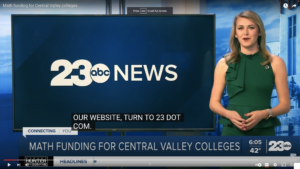 The College Bridge Dual Enrollment Math Bridge Project, in partnership with the Central Valley Higher Education Consortium , was featured by KERO23-ABC in Bakersfield with reporter/anchor Ava Kershner interviewing Dr. Lynn Cevallos, founder and president of College Bridge, and Armin Rashvand, the Taft College dean of instruction.
The College Bridge Dual Enrollment Math Bridge Project, in partnership with the Central Valley Higher Education Consortium , was featured by KERO23-ABC in Bakersfield with reporter/anchor Ava Kershner interviewing Dr. Lynn Cevallos, founder and president of College Bridge, and Armin Rashvand, the Taft College dean of instruction.
